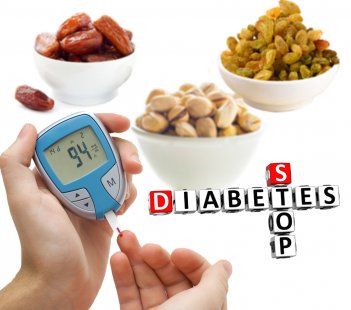
Pistachios have more total carbohydrates (29% w/w) than do other nuts, but their consumption has no deleterious effect in subjects with abnormal glucose and insulin metabolism.
Pistachios help to decrease the risk of diabetes
Pistachios have more total carbohydrates (29% w/w) than do other nuts, but their consumption has no deleterious effect in subjects with abnormal glucose and insulin metabolism.
Data from several epidemiological studies and clinical trials suggest that the frequency of nut consumption is inversely related to an increased risk of T2DM (type 2 diabetes mellitus). This may be because of the fact that nuts are relatively high in fiber, healthy fats, antioxidants, and anti-inflammatory content. In addition, among all nuts, pistachios have a low glycemic index, suggesting that they may reduce postprandial glycemia and insulinemia and therefore contribute to reducing the T2DM risk.
Several clinical studies have investigated the effect of pistachio consumption on glucose concentrations. They observed a significant decrease in fasting plasma glucose (FPG), in glucose but not in insulin blood levels and in both FPG and insulin levels after pistachio intake.
Pistachio consumption has also proved to have beneficial effects on diabetes control.
Pistachio intake has also recently been found to significantly enhance the glucose and insulin metabolism of prediabetic patients and improve insulin resistance status and other cardiovascular risk factors [1].
Raisins in Diabetes Management
Raisins, like all commonly consumed fruits, provide carbohydrates as the only caloric macronutrient, many questions arise as to when and how much fruit should be consumed. The American Diabetes Association recommends following a dietary pattern, which includes carbohydrates from fruits, vegetables, whole grains, legumes, and low-fat milk, as well as monitoring dietary carbohydrates, whether by carbohydrate counting, exchanges or experience-based estimates, to achieve glycemic control. The use of the Glycemic Index in addition to the consideration of total carbohydrate may provide an added benefit. Of course, frequent blood glucose monitoring is strongly recommended, as it indicates which foods, physical activities and/or meal times elevate blood glucose levels. Individuals diagnosed with diabetes should work with a registered dietician to create a meal plan that accommodates the patient’s weight, medication, carbohydrate needs, and lifestyle.
In addition to their high antioxidant activity and dietary fiber content, raisins have a low to moderate Glycemic Index – a measure of how a food affects blood sugar levels. These three factors are important tools in diabetes management [2].
Read more about benefits of Raisin
Dates help to reduce the risk of many disease conditions such as diabetes
The dietary fiber content of dates can further contribute to their nutritional significance as dates can be used in the preparation of fiber-based foods and dietary supplements. Daily intake of 100 g of dates can meet the 32% of the recommended dietary allowance for dietary fiber. Higher content of the insoluble fiber induces satiety and has a laxative effect due to increased stool weight. Dietary fiber exhibits many therapeutic benefits and helps in lowering the blood cholesterol levels and has been shown to reduce the risk of many disease conditions such as diabetes, hypertension, bowel and colon cancers, cardiovascular diseases, and diverticulosis [3].
Read more about benefits of Dates
Taher Agroindustrial Group is located in the main pole of pistachio producer cities in Iran. Taher Company has safe marketing management in all process from farm to warehouses and export ports and tries to have quick transportation with establishing modernize pistachio processing terminals.
References:
1- Pablo Hernández-Alonso st al, “Pistachios for Health-What Do We Know About This Multifaceted Nut?”- 2016
2. Arianna Carughi, “Health Benefits of Sun-Dried Raisins”- 2012
3. Amanat Ali et al, “Nutritional and Medicinal Value of Date Fruit”- 2012






User comments